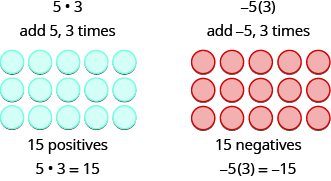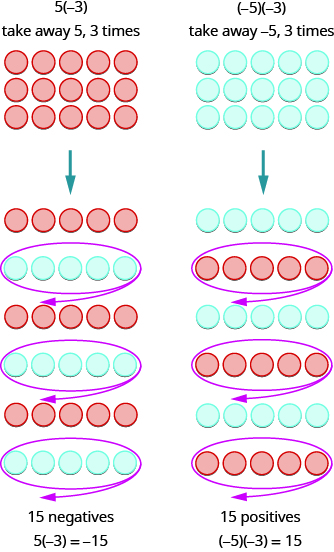| << Chapter < Page | Chapter >> Page > |
Before you get started, take this readiness quiz.
Since multiplication is mathematical shorthand for repeated addition, our counter model can easily be applied to show multiplication of integers. Let’s look at this concrete model to see what patterns we notice. We will use the same examples that we used for addition and subtraction.
We remember that means add times. Here, we are using the model shown in [link] just to help us discover the pattern.

Now consider what it means to multiply by It means subtract times. Looking at subtraction as taking away , it means to take away times. But there is nothing to take away, so we start by adding neutral pairs as shown in [link] .

In both cases, we started with neutral pairs. In the case on the left, we took away times and the result was To multiply we took away times and the result was So we found that
Notice that for multiplication of two signed numbers , when the signs are the same, the product is positive, and when the signs are different, the product is negative.
The sign of the product of two numbers depends on their signs.
| Same signs | Product |
|---|---|
| •Two positives
•Two negatives |
Positive
Positive |
| Different signs | Product |
|---|---|
| •Positive • negative
•Negative • positive |
Negative
Negative |
Multiply each of the following:
| ⓐ | |
| Multiply, noting that the signs are different and so the product is negative. |
| ⓑ | |
| Multiply, noting that the signs are the same and so the product is positive. |
| ⓒ | |
| Multiply, noting that the signs are different and so the product is negative. |
| ⓓ | |
| The signs are the same, so the product is positive. |
When we multiply a number by the result is the same number. What happens when we multiply a number by Let’s multiply a positive number and then a negative number by to see what we get.
Each time we multiply a number by we get its opposite.
Multiplying a number by gives its opposite.
| ⓐ | |
| The signs are different, so the product will be negative. | |
| Notice that −7 is the opposite of 7. |
| ⓑ | |
| The signs are the same, so the product will be positive. | |
| Notice that 11 is the opposite of −11. |
Division is the inverse operation of multiplication. So, because In words, this expression says that can be divided into groups of each because adding five three times gives If we look at some examples of multiplying integers , we might figure out the rules for dividing integers .

Notification Switch
Would you like to follow the 'Prealgebra' conversation and receive update notifications?